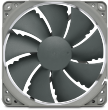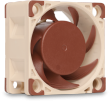Arctic F12 Pro TC, Temp Controlled High Performance Rear Fan Discontinued | |
| More variations available Show | |
Arctic Cooling Arctic F12 Pro TC, Temp Controlled High Performance Rear Fan
The intelligent programmed temperature controller and accurate temperature detection make ARCTIC F Pro TC the best TC fans in the market.
Unlike other generic temperature controlled case fans, the ARCTIC F Pro TC fan provides cooling according to not only the temperature, but also the overall necessity for cooling.
The revolutionary programmed temperature controller plays a key role. As shown in the chart, when case ambient air temperature is at safe level 0C to 32C, the ARCTIC F Pro TC fan speed remains at its lowest (500 rpm). This is to offer adequate ventilation at the lowest noise level possible. The ARCTIC F Pro TC is therefore completely inaudible (0.05 sone) at low temperatures a much quieter level than generic TC fans.
However, once a gaming system is at load, the case ambient air temperature will rise, most likely it will rise above 40C, an overheated level for most PC cases. High performance and instant cooling is vital at this stage in order to eliminate the risk of overheating and system instability.
The ARCTIC F Pro TC is programmed to achieve top fan speed at 38C. The fan responds to the rise in temperature swiftly within a critical 6C range, the rpm of the ARCTIC F Pro TC fan increases from around 500 to its maximum of 2,000 rpm (the steep curve in the chart). Heat is dissipated from the case rapidly in order to achieve immediate cooling. As a result, the case air temperature remains at 38C or below and thus the possibility of having a system failure can be eliminated.

The accurate temperature sensor of the ARCTIC F Pro TC is equipped at the end of a 40cm cable. This gives much better flexibility when choosing the most appropriate spot that users would like to have the temperature detection.
Features
- Temperature sensor on a 40cm long cable
- Accurate case temperature detection
- Cable can be positioned in wherever necessary
- Extremely quiet - only 0.4 Sone
- Patented fan holder eliminates the buzzing sound
- Patented vibration absorption
| Specifications | Arctic F12 Pro TC |
|---|---|
| Dimensions | 120 L x 120 W x 38.5 H mm |
| Fan Speed | 400 - 1300 RPM |
| Air Flow | 33 CFM / 55.8 m3/h |
| Noise Level | 0.4 Sone (approx. 22 dBA) |
| Weight | 140 g |
| Warranty | 72 months |
| EAN barcode | 0872767002418 |
| Specifications | Arctic F12 Pro TC |
|---|---|
| Dimensions | 120 L x 120 W x 38.5 H mm |
| Fan Speed | 400 - 1300 RPM |
| Air Flow | 33 CFM / 55.8 m3/h |
| Noise Level | 0.4 Sone (approx. 22 dBA) |
| Weight | 140 g |
| Warranty | 72 months |
| EAN barcode | 0872767002418 |
Customer Reviews
Sheer genius
PSU fans are temperature sensitive, and (exhaust) case fans should be too. The temperature range Artic has chosen here looks conservative but it actually works well. The fan is damped on little rubber bands like a studio mic, but it’s quiet enough that this probably isn’t necessary. The thermocouple-on-a-string probably isn’t necessary either - you could just put it in the housing and achieve the same effect with less risk of fouling.
My only criticism would be that the holes have no thread, and to mount the fan without fumbling you have to tap them first with a screw. This will take you all of 44 seconds longer.
No, it is not reversible, but a quiet PC shouldn’t need inlet fans anyway. This part is exhaust only.
It’s cheap. It works. Get two.
Sadly not reversible
I fitted one to my computer case I would have fitted two but unless I am mistaken there is no way of reversing the fan, because of the design they only fit one way, shame they are very well made for the money.
Product Resources
FAQ
How do I measure fan size?
The size of fan you need will generally be determined by the size of the fan fitting position in your PC case. The sizes of all the fans on our website are shown as measured along any one of the fan’s four sides, NOT the distance between the fan’s screw holes! Our most popular fan size is 120mm, followed by 80mm. This isn’t really dictated by customer preference, but more by recent designs of PC cases.
As for the thickness (depth) of the fan, generally 25mm (1 inch) is by far the most common depth, although smaller fans can have shallower depths such as 15mm or even 10mm. All our fans are 25mm thick unless otherwise stated. If you have any questions about which fan you should order, please don’t hesitate to get in touch.
If you know the distance between the fan mounting screw holes but don’t know what fan size to order, please see the following table. Note that the mounting hole measurements shown below are taken horizontally or vertically between the holes and not diagonally.
Screw hole spacings and fan sizes
Space Between Screw Holes Fan Size 32mm 40mm 40mm 50mm 50mm 60mm 60mm 70mm 72mm 80mm 83mm 92mm 105mm 120mm I received a small cable (resistor) with my fan; what is it for?
The resistor cable (also called Ultra Low Noise or ULN cable) is designed to allow the fan to run slightly slower for even quieter operation. The benefit in lower running noise is significant. Although the airflow will be reduced slightly, this usually has minimal effect on PC temperature. We would generally recommend using the ULN resistor cable for best results in almost all circumstances.
How can I tell which way the air blows through the fan?
Hold the fan so that the round fan sticker is facing you. You are looking at the rear of the fan. When you plug the fan in, the air will be blowing towards you. If you want a fan to act as an air intake, then the fan sticker will be facing the inside of the case. Some fans also have two small arrows moulded into their plastic housing - one arrow shows the direction of airflow, and the other (at 90°) shows the direction of blade rotation.
Is it possible to use a 4-pin PWM fan or CPU cooler with a motherboard which has only 3-pin fan headers on it?
Electrically, there is no problem doing this - the fourth pin on the fan cable is used purely for PWM control and is not needed in order for the fan to run. So you can plug the 4-pin fan connector onto the 3-pin motherboard fan header, leaving the fourth pin not connected to anything. The fan will potentially run at full speed, so if you would like to reduce the speed of the fan you will need to adjust the fan speed setting in your BIOS or use fan control software such as SpeedFan in Windows.
The only other problem to consider is that occasionally, components immediately adjacent to the motherboard fan header can get in the way of the larger 4-pin fan connector, physically preventing connection. This problem also occurs if you try to use an in-line fan speed controller such as the one made by Gelid.
Another avenue to explore is the possibility of using a bay-mounted fan controller. Several models are available now which provide 4-pin fan headers, so this is an easy way to use 4-pin PWM fans in a PC system which has only 3-pin fan headers on its motherboards. When using this method, you may find it necessary to disable any fan warning settings in your motherboard BIOS, since the motherboard may incorrectly believe that its CPU fan has failed when the fan is connected to a fan controller rather than directly to the motherboard itself.
Top Quiet Fans

Noctua NF-A20 PWM 5V 800RPM 200x30mm Extra Large Quiet Fan

Noctua NF-A12x25 PWM chromax.black.swap 12V 2000RPM 120mm Fan

Noctua NF-S12B REDUX 12V 700RPM 120mm Quiet Case Fan

Noctua NF-A6x25 PWM 12V 3000RPM 60x25mm Low Noise Fan

Noctua NF-P12 REDUX PWM 12V 1700RPM 120mm Quiet Case Fan

Noctua NF-A12x15 PWM chromax.black.swap 12V 1850RPM 120x15mm Fan

Noctua NF-A14 PWM chromax.black.swap 12V 1500RPM 140mm Fan

Noctua NF-F12 iPPC PWM 12V 3000RPM 120mm High Performance Fan

Noctua NF-A14 PWM 12V 1500RPM 140mm Premium Quality Fan

Noctua NF-A4x20 PWM 12V 5000RPM 40x20mm Quiet Cooling Fan


